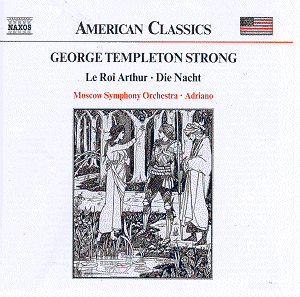Adriano tells us, in his detailed programme note, that
the works of Strong were recommended to him by Ernest Ansermet whom
he met in 1967. Later a friend added sparks and smoke to the kindling
with a tape of Toscanini's broadcast of Die Nacht (21 October 1939).
When a large cache of Strong's scores came into Adriano's possession
in the early 1990s the seal was well and truly set.
Strong went to Leipzig in 1879 to study with Jadassohn
and then fell in with Liszt and his Weimar circle. There he came under
the thrall of programme music. He lived in Germany for much of his late
youth there meeting Edward MacDowell whose (much more concise) orchestral
music can be seen as a parallel. After a brief visit to the USA in 1891-2
he returned to Europe residing then in Switzerland. The Flonzaley quartet
played his music. In 1930, eighteen years before his death he donated
most of his scores to the Library of Congress despite his indignation
about the rejection of his music by American orchestras. The symphonic
suite Une Vie d'Artiste (another Heldenleben, I wonder)
was premiered at the 20th Festival of the Association of Swiss Musicians.
This was in June 1920. It is scored for violin and orchestra. Strong's
home during his Swiss years was at Vevey on Lake Geneva where he became
increasingly drawn to watercolour paintings. (I wonder if any have survived
- if so they might be used as the cover for later instalments in this
series). Strong founded the Société Vaudoise des Aquarellistes.
Die Nacht can best be thought of as a
tone poem in four movements. The movements are: At Sunset, Peasant's
Battle March, In an Old Forest and The Awakening of the Forest-Spirits.
The music is at its most accomplished and communicative in the Sunset
and Old Forest (I and III) episodes. Here Strong is ruminative and mysterious.
He falls prey to raucous temptations in the Peasant's March (where the
orchestra's polish noticeably lapses) and in The Awakening. The rough-edged
gangling march is apt in its awkward edges. The Awakening has more successful
music than not. Stylistically speaking, with this work, we are at the
delta of influences from Berlioz (there is some extremely colourful
and imaginative writing especially in the final episode), Liszt, Dukas,
Mendelssohn (faerie music) and Wagner (Walküre in The
Awakening). Raff is another reference point though Strong is much
better at sustaining mystery and mood.
The Arthurian Legends have spawned a wide range of
music. Examples include Chausson's opera Le Roi Arthus and his
tone poem Viviane, Ropartz's 1912 tone poem Le Chasse du Prince
Arthus, Rutland Boughton's cycle of Arthurian operas (most never
performed), Albert Coates' Lancelot and Elaine symphony. Macdowell's
Lancelot and Elaine, Merlin operas by Goldmark, Albeniz,
Ladmirault and Inglis Gundry, Elinor Remick Warren in her Legend
of King Arthur and fellow American Louis Coerne's tone poem Excalibur
recorded by Karl Krueger on MIA141 in long departed LP days.
There is some delightfully Straussian or even Mahlerian
succulent horn writing at 6.10 in the first of the three movements.
This music also taxes the orchestra who hold onto coordination by the
skin of their teeth. The slow tread of the adagio-andante is reminiscent
of a rather primeval Mahler. The suggestion of disarming innocence amid
the eldritch is strong. It is a small step from the Erben-based works
of Dvorak and Fibich to this music. Dvorak and Fibich are, however,
more concentrated and succinct. The music is much stronger in the finale
where the tragic legacy of betrayal by Lancelot and by Guinevere breathes
in music of the considerable mastery worthy at last of Strong's ambitious
reach.
Though not so labelled, this is the second volume in
Naxos's Strong Edition. It will encompass the complete orchestra works
in the fullness of time.
This disc was sponsored by the Czeslaw Marek Foundation
of Zürich.
There are three symphonies in all. No. 1 is In den
Bergen; No. 2 is Sintram (recorded by Adriano and in LP days
by Karl Krueger) and No. 3 An der See. Grove 5 (yes, that's two
editions back - I have not checked the latest Grove) tells us that the
First Symphony was successfully played in the States and in Europe.
Other works we can hope will be among Adriano's schedule include the
symphonic poem, Undine, a symphonic idyll An der Nixenquelle
as well as pieces for soli, chorus and orchestra: Knights and
Dryads, Wie ein fahrender Hornist sich ein Land erblies and
Die Verlassene Mühle.
The first volume (NAXOS 8.559018) was reviewed
here in January 2000. It included the second recording ever of Strong's
Sintram Symphony and Hassler Chorale. When I reviewed
this I said that I awaited the second volume with the keenest curiosity.
Well, roll on the third disc.
I rather hope that someone can volunteer to me a list
of Strong's works with dates and if possible dates and details of premieres.
These are pleasingly discursive late-romantic canvases
which sit easily with the pictorial works of Raff, and Huber.
Rob Barnett


